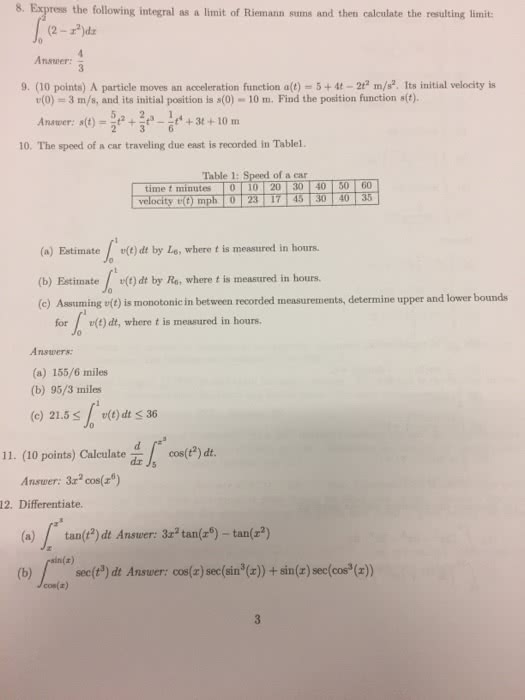APPM 2350 Midterm: appm2350fall2014exam1_0

APPM 2350 EXAM 1 FALL 2014
1. (20 points) For each of the following unrelated questions, answer either ALWAYS TRUE or NOT ALWAYS TRUE. For
this problem, no justification is necessary.
(a) A·(B×C) = (A×B)·C.
(b) If A×B=C×Band B6= 0, then A=C.
(c) If an object moves on the surface of a sphere, then its acceleration vector, a, is orthogonal to its velocity vector, v.
(d) If a particle’s position vector and velocity vector have constant magnitude, then the position vector and the accelera-
tion vector are orthogonal.
2. (20 points) Consider the surface consisting of all points that are equidistant from the point (0,0,1) and the plane z=−1.
(a) Determine the equation describing the surface.
(b) Identify the surface described in part (a).
3. (20 points) Years ago, some engineering students built a small “lighthouse” that used a laser instead of a normal light. The
laser rotated a full 2πradians in one minute. Your may assume that the origin is at the center of the base of the lighthouse,
with the xand yaxes in horizontal directions, and zin a true vertical direction. Unfortunately, one of the young engineers
made some errors and the foundation of the lighthouse shifted. Instead of being vertical, the lighthouse is now tilted. In
particular, the central axis of the lighthouse has the (non-unit length) direction D= 0 i+ 1 j+ 20 k, and the rotating laser
is located at (0,1,20). When the laser beam rotates now, the laser dots hits a wall described by 20y+ 10z= 40. As the
laser dot moves across this wall, it moves along a straight line in 3-D space. In what direction does the laser dot move?
You should provide a full i-j-kdescription for the direction of the laser dot moving on the wall. Your direction vector need
not be of unit length.
4. (20 points) Consider a particle moving along a path r(t)with a constant speed of 3. We also know that at the particular
time t=t∗the following is true:
r(t∗) = 3 j−2k T(t∗) = (i+ 2 k)/√5N(t∗) = −jκ(t∗) = 2
Calculate the following quantities, if you can, and be sure to justify your calculation. If the quantity cannot be calculated,
explain why.
(a) Bin terms of i,j, and k, at time t∗.
(b) vin terms of i,j, and k, at time t∗.
(c) ain terms of i,j, and k, at time t∗.
(d) v·aat the new time t= 10t∗.
5. (20 points) Determine the functions x(t),y(t), and z(t), such that the parameterization of the path r(t) = x(t)i+y(t)j+
z(t)ksatisfies the following unrelated descriptions:
(a) The line through the points (2,1,−1) and (0,7,−3).
(b) The helix of radius 3 centered at the origin that makes one full counterclockwise revolution between the points
(0,3,0) an (0,3, π).
(c) The curve x=z3in the y= 5 plane.
(d) The curve of intersection of the cylinder x2+y2= 1 and the plane x+z= 2.
OVER
Document Summary
Fall 2014: (20 points) for each of the following unrelated questions, answer either always true or not always true. The laser rotated a full 2 radians in one minute. Your may assume that the origin is at the center of the base of the lighthouse, with the x and y axes in horizontal directions, and z in a true vertical direction. Unfortunately, one of the young engineers made some errors and the foundation of the lighthouse shifted. Instead of being vertical, the lighthouse is now tilted. In particular, the central axis of the lighthouse has the (non-unit length) direction d = 0 i + 1 j + 20 k, and the rotating laser is located at (0, 1, 20). When the laser beam rotates now, the laser dots hits a wall described by 20y + 10z = 40. As the laser dot moves across this wall, it moves along a straight line in 3-d space.

